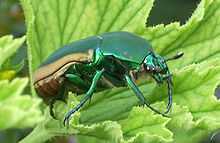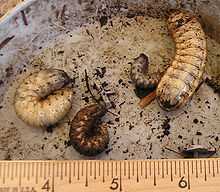Figeater beetle
| Figeater beetle | |
|---|---|
 | |
| Scientific classification | |
| Kingdom: | Animalia |
| Phylum: | Arthropoda |
| Class: | Insecta |
| Order: | Coleoptera |
| Family: | Scarabaeidae |
| Subfamily: | Cetoniinae |
| Tribe: | Gymnetini |
| Genus: | Cotinis |
| Species: | C. mutabilis |
| Binomial name | |
| Cotinis mutabilis Gory & Percheron, 1883 | |
Cotinis mutabilis, also known as the figeater beetle (also green fruit beetle or fig beetle and also junebug), is a member of the scarab beetle family. It belongs to the subfamily Cetoniinae, comprising a group of beetles commonly called flower chafers since many of them feed on pollen, nectar, or petals. Its habitat is primarily the southwestern United States and Mexico. Figeater beetles are often mistaken for green June beetles (Cotinis nitida) and occasionally Japanese beetles (Popillia japonica), which occur in the eastern US; however, they are not capable of damaging leaves and fruit as adults (they only feed upon already-injured fruits) and do not damage lawns as larvae to the same extent as their eastern cousins.
Adult figeater beetles grow to approximately 1.25 inches (3 cm). They are a semi-glossy green on the top and a brilliant iridescent green on the underside and legs. They are active during daylight hours, often congregating in the shade of trees near choice breeding grounds to find mates. They make a loud buzzing sound similar to that of carpenter bees, possibly because it does not need to open its elytra in order to fly, an ability shared with many other flower beetles.
Life cycle

Figeater beetle larvae, commonly called "crawly backs",[1] grow up to 2 inches (5 cm) and are thick and white with a dark head. They have six small, ineffectual legs—to move, they roll onto their backs and propel themselves upside down, using the stiff dark hairs on their backs to gain traction. At rest, they curl into a firm C shape.
Pupation occurs in the spring; adults emerge from July–September (varies with location). After mating, eggs are laid in decaying matter or compost piles, which provide sustenance for the larvae when they emerge.
Taxonomy
The figeater beetle (Cotinis mutabilis) is often confused with the green June beetle (Cotinis nitida). They are both members of the flower beetle subfamily[2] (Cetoniinae), and their appearance is quite similar, but the green June beetle is smaller, and its range is in the eastern United States. The only possible crossover of both species is in Texas.
References
- ↑ http://www.whatsthatbug.com/2010/01/10/crawly-back-figeater-larva/
- ↑ Kaufman Field Guide to Insects of North America
External links
| Wikispecies has information related to: Figeater beetle |
| Wikimedia Commons has media related to Cotinis mutabilis. |